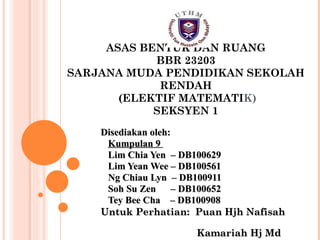Kumpulan 09
- 1. ASAS BENTUK DAN RUANG BBR 23203 SARJANA MUDA PENDIDIKAN SEKOLAH RENDAH (ELEKTIF MATEMATI K) SEKSYEN 1 Disediakan oleh: Kumpulan 9 Lim Chia Yen â DB100629 Lim Yean Wee â DB100561 Ng Chiau Lyn â DB100911 Soh Su Zen â DB100652 Tey Bee Cha â DB100908 Untuk Perhatian: Puan Hjh Nafisah Kamariah Hj Md
- 2. THE DEVELOPMENT OF SPATIAL AND GEOMETRIC THINKING : CO-ORDINATING SPACE IN DRAWINGS
- 3. STAGES OF DEVELOPMENT IN CHILDRENâS SPATIAL THINKING Preaxial Schema (4 years) Uniaxial schema (6 years) Biaxial Schema (8 years) Intergrated Biaxial (10 years)
- 4. The child represents the component shapes of an object and the locations of objects within a rectangular field. Preaxial Schema (4 years)
- 5. Ėý
- 6. The child can specify an objectâs internal shapes and spatial relations and its location relative to the edge of the field. Example: the relative heights of people a shown from the same baseline. Uniaxial Schema (6 years)
- 7. Ėý
- 8. The child mentally sets up two separate location fields within the main field â usually as foreground and background and so uses two separate reference lines for heights. Biaxial Schema (8 years)
- 9. Ėý
- 10. The child co-ordinates the whole field with both horizontal and vertical axes used as references. Drawings contain âmiddle groundâ linking foreground and middle ground. Intergrated Biaxial (10 years)
- 11. Ėý











